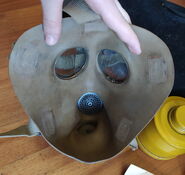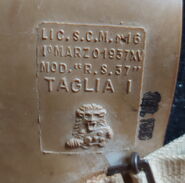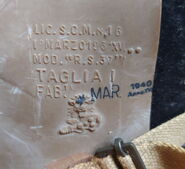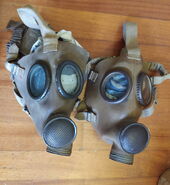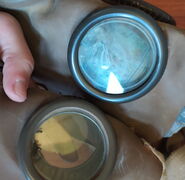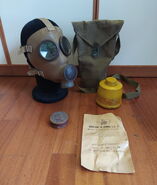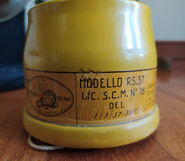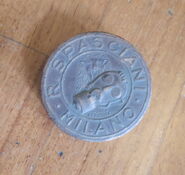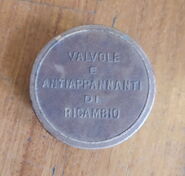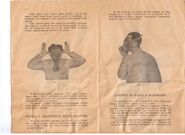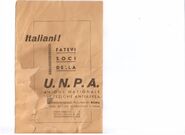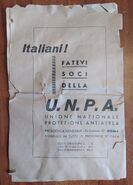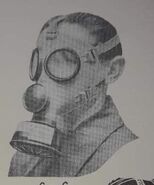The R.S. 37 and RS-37 were Spasciani's non-military T.35 variant. Two main variants were produced, one for civilian use mostly before the war and the other for industrial purposes after the war.
Mask overview[]
The mask is composed of the following parts:
The faceblank, made of moulded rubber, has the following parts attached to it:
- the housing for the exhale valve (outlet)
- the metal threaded piece that allows the filter to be screwed in and houses the inlet valve (inlet)
- the eyepieces
- the straps
The inhale valve allows filtered air in from the filter and does not allow exhaled air to go back out from the filter again. Said rubber valve is housed in the metal threaded piece.
The exhale valve allows exhaled air to go outside and prevents poisoned air to get in. It's made of rubber, it opens under the light pressure of exhaling and closes hermetically under the negative pressure produced by the inhalation. It can be easily inspected and possibly replaced by unscrewing the lid of its housing.
The eyepieces are made of "Triplex" glass, which itself is composed of two glass layers and a thin sheet of cellulose. This kind of glass prevents poisoned air to get into the mask even after being hit, as only the outside layer of glass would be shattered and the other two layers would maintain the seal. The glasses are affixed to the mask through aluminium frames.
The elastic harness has the goal to keep the mask tightly onto the face. It is composed of 5 adjustable straps (a top one, two elastic temple ones and two elastic cheek ones) attached to the facepiece, and they gather into a nape pad. Industrial RS-37 masks have a slightly different design.
The anti-fogging disks are kept tightly onto the lenses by metal inserts and serve the purpose of maintaining good visibility.
R.S. 37[]
Overview[]
The R.S. 37 was the 16th gas mask approved by the S.C.M. (Servizio Chimico Militare, chemical military service) on 1 March 1937. It was almost identical to its military counterpart (the T.35), save for the marking.
R.S. 37 masks made during 1940 or later are manufactured to a lesser standard, with cheaper rubber, head-harness, exhale valve cover and in some cases with differently coloured furniture.
Kit[]
The mask came with the following kit:
- dedicated R.S. 37 filter
- T.35-style bag
- manual
- a small paper box (containing a spare exhale valve a spare inhale valve and anti-fogging lenses)
Manual[]
This manual is pretty different from other T.35-related ones, but it still uses some of the pictures taken by Pirelli.
Due to the fragile paper used, the conditions are often not the best, and a couple more pictures have been added to the gallery to make the front and back more readable.
RS-37[]
After the end of the war, Spasciani made an updated version of the R.S. 37 with rubber straps, exclusively intended for industrial use. The rubber harness had cloth engrained in the top strap and nape pad to make those rigid. These masks follow Spasciani's own sizing system, in which size 1 is the smallest and 3 is the largest.



